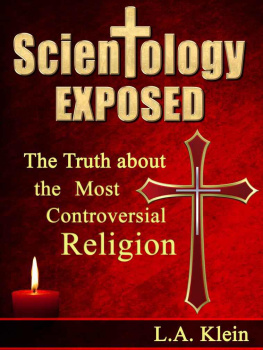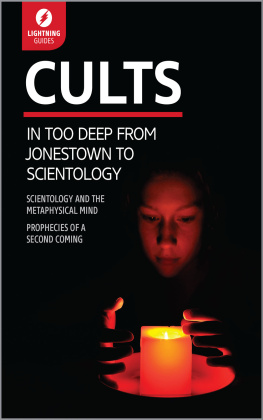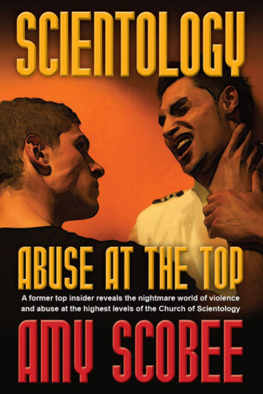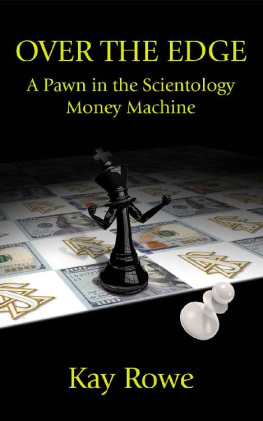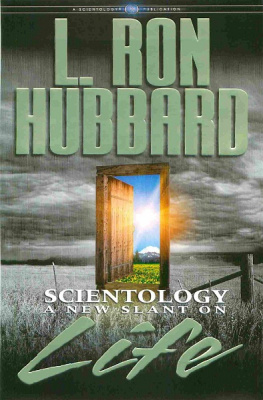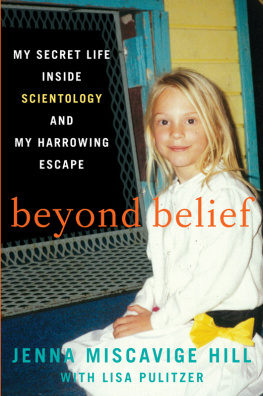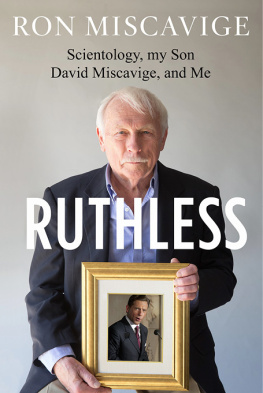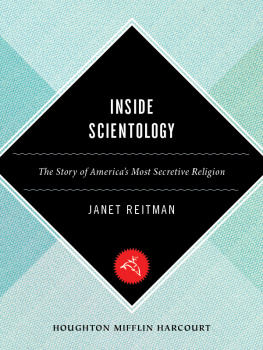Scientology Exposed: The Truth aboutthe World's Most Controversial Religion
Disclaimer:
Every effort has been made to make our books and reports asaccurate as
possible, however, there may be mistakes, both typo and incontent. This
content should be used as a general guide and not as thesolution.
The author and publisher shall have neither liability norresponsibility
to any person or entity with respect to any loss, damage oralleged to
be caused directly or indirectly by information provided in thisreport
or Book.
This report is Copyright 2012 by Lambert Klein
All Rights Reserved
Intro
Welcome to the Scientology Exposed. This is L.A. Klein, andin this book we'll be covering the basics of Scientology, as well as the moremysterious aspects of it that most people are unaware of. One thing you shouldbe aware of is the fact that this book seeks to present this subject matter asobjectively and unbiased as possible. I'm not trying to convert you toScientology, and I'm not trying to misrepresent it either. Ultimately yourviews and opinions about Scientology are up to you.
That being said, it is true that there are a lot ofmisconceptions about Scientology. Considering the unique nature of the religionand the fact that it is often misrepresented in the media and by word of mouth,it can be hard to tell fact from fiction. On top of that there are manyconspiracy theories and stories about Scientology that are presented from abiased perspective, especially on the Internet.
Further muddling the truth is the fact that the reality ofScientology is often times weirder than the conspiracy theories andmisinformation that is spread around about it. This has led to many peoplehaving a warped view of Scientology and many more not really knowing what tothink about it. This book will clear up these misconceptions and give you achance to take an honest look at Scientology.
Perhaps one of the most fascinating things about Scientologyis the fact that it attracts big name celebrities such as Tom Cruise and JohnTravolta. We'll get to the bottom of this phenomenon and see what makes thisreligion so appealing to them and even go over a few specific examples. Thetruth may surprise you.
Chapter 1: History of Scientology
I have high hopes of smashing my name into history soviolently that it will take a legendary form even if all books are destroyed.- L. Ron Hubbard
Before we begin to dig into the best kept secrets ofScientology, let's go over the basics. This will help you get a clearunderstanding of what this religion is all about and how it works. One thing ofparticular note is the fact that the Church of Scientology is officiallyrecognized as a religion in some countries while not in others. Here is a listof those that recognize it and those that don't:
Countries that Recognize Scientology as a Religion:
UnitedStates of America
Sweden
Spain
Portugal
Slovenia
Croatia
Hungary
Kyrgyzstan
Republicof China (Taiwan)
Australia
Countries that Don't Recognize Scientology as a Religion:
Germany
Canada
France
Greece
Belgium
UnitedKingdom
Finland
Israel
Mexico
Russia
Interestingly enough, when Scientology was first introducedin the 50's, it was recognized as a religion by the US, only to have thatstatus revoked by the IRS later in 1967. It would be over a quarter of acentury before Scientology gained recognition as a religion once again in 1993.
What Does Scientology Mean?
The term Scientology can be traced back as far as 1901, used by author Allen Upward. It was defined as a disparaging term, to indicate a blind, unthinking acceptance of scientific doctrine. This use of the word would have nothing at all to do with the religion of Scientology that would arise over fifty years later, yet many people who have no knowledge of the Church of Scientology often times think this is an accurate definition.
The modern usage of the word Scientology is a combination ofthe Latin words sciens (knowing) and logos (the study of). However, theexact meaning translates to something more along the lines of the study andhandling of the spirit in relationship to itself, universes, and other lifeaccording to the Church of Scientology.
Dianetics
Scientology was founded by pulp fiction author L. Ron Hubbard who specialized in writing science fiction. He was also the creator of Dianetics, a self-help system. Dianetics centered around using a form of psychotherapy known as auditing to allow individuals to relive past traumatic experiences and release them.
Dianetics was rejected by the medical community in the late40's, yet Hubbard continued to gain supporters and eventually had a modestfollowing with the book Dianetics: The Modern Science of Mental Healthbecoming a New York Times best-seller. This in turn led to the founding of theHubbard Dianetic Research Foundation in Elizabeth, New Jersey.
The organization was short lived however. Repeated criticismfrom the medical community led to the New Jersey Board of Medical Examinersinstituting legal proceedings against Hubbard's organization for teachingmedicine without a license. Oddly enough, this seemed to contradict the claimsof many detractors in the medical community who claimed that Dianetics wasn't atrue medical practice. In any case, the legal proceedings led to the bankruptcyof Hubbard's organization
The Church of Scientology
While Hubbard's financial resources had been depleted, he still had a modest following that was continuing to grow. While some members were still hoping that Dianetics would be taken seriously in the medical community, Hubbard went in the opposite direction.
The break from the medical science angle came due to thefact that many users of Dianetics reported experiencing memories of past lives.The Dianetics community was divided over this, but Hubbard sided with thoseespousing these claims, essentially killing all hope of getting Dianeticsrecognized as medical science.
Whereas Dianetics was rejected as medical science, TheChurch of Scientology would come to be accepted as a religion.
In 1952, Hubbard published new teachings. Using Dianetics asa foundation, Scientology was officially born. A year later, three officialchurches would be founded in Camden, New Jersey: the Church of SpiritualEngineering, the Church of American Science, and the Church of Scientology.
The movement continued to grow and in 1954 the Church ofScientology of California was founded. Gaining international momentum, a churchwas also founded in Auckland, New Zealand.
Expansion and Conflict
As the years passed, more churches were founded, and in 1957 the movement was officially recognized as a religion by the IRS, giving it tax-exempt status. However, this major victory was tempered by the challenges that were to come.
In the early 60's, the Church of Scientology came intoconflict with the Food and Drug Administration over the use of devices known asE-meters. This culminated in a raid by the FDA in which they seized hundreds ofE-meters proclaiming that they were illegal medical devices. This claim wasseemingly contradicted by the FDA itself a short time later when they requiredthat all E-meters must carry a disclaimer stating that it is only a religionartifact.
More trouble for the Church of Scientology began whenseveral Australian states began to ban the religion, starting with Victoria in1965. The reason for the ban was based on the Anderson Report, whichstated that the auditing process involves command hypnosis in which theauditor assumes direct control over the person being audited.
The Church of Scientology spent decades fighting the ban inan attempt to overturn it. In the meantime they operated under the name Churchof New Faith. The Psychological Practice Act 1965, the document thatessentially banned Scientology, was amended in 1982 to remove all references tothe Church of Scientology, in effect ending the ban. The entire piece oflegislation was repealed in 1987.
Next page
